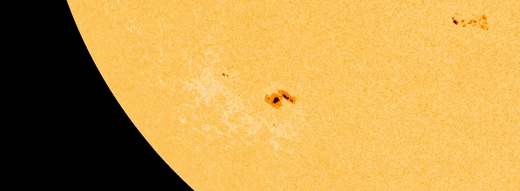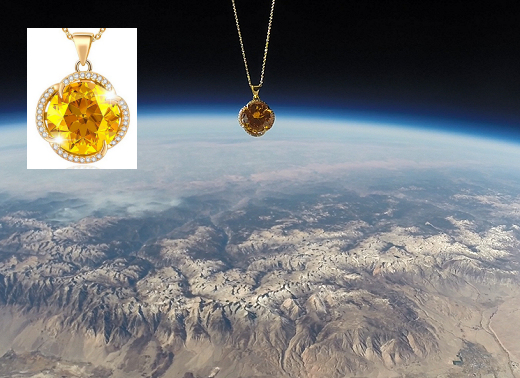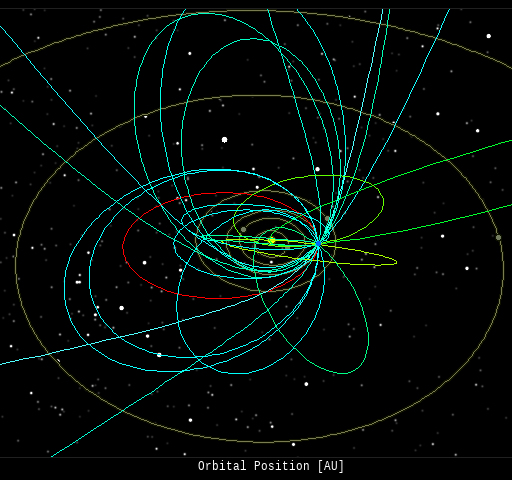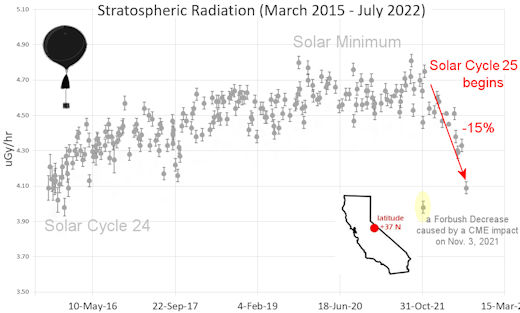 | | | Switch to: Europe, USA, New Zealand, Antarctica Credit: NOAA/Ovation  Planetary K-index Planetary K-index
Now: Kp= 0 quiet
24-hr max: Kp= 2 quiet
explanation | more data
Interplanetary Mag. Field
Btotal: 9.53 nT
Bz: 7.37 nT north
more data: ACE, DSCOVR
Updated: Today at 1146 UT  Coronal Holes: 17 Sep 22 Coronal Holes: 17 Sep 22 
Solar wind flowing from this northern coronal hole could graze Earth's magnetic field on Sept. 17-18. Credit: SDO/AIA  Noctilucent Clouds Noctilucent Clouds
Noctilucent cloud season is underway--but also nearing its end. AIM images show the polar ring of NLCs is contracting as northern summer winds down. Switch view: Europe, USA, Asia, Polar Updated Sep17  SPACE WEATHER
NOAA Forecasts | | Updated at: 2022 Sep 17 2200 UTC FLARE | 0-24 hr | 24-48 hr | CLASS M | 20 % | 20 % | CLASS X | 05 % | 05 % |  Geomagnetic Storms: Geomagnetic Storms:
Probabilities for significant disturbances in Earth's magnetic field are given for three activity levels: active, minor storm, severe storm Updated at: 2022 Sep 17 2200 UTC Mid-latitudes | 0-24 hr | 24-48 hr | ACTIVE | 30 % | 15 % | MINOR | 10 % | 05 % | SEVERE | 01 % | 01 % | High latitudes | 0-24 hr | 24-48 hr | ACTIVE | 15 % | 15 % | MINOR | 20 % | 15 % | SEVERE | 30 % | 10 % | | | |  | | | | | | | | | | | Never miss another geomagnetic storm. Sign up for Space Weather Alerts and you'll receive a text message when magnetic storms erupt. Aurora tour guides and professional astronomers use this service. You can, too! | | | SLIGHT CHANCE OF STORMS TODAY: A high-speed stream of solar wind is expected to graze Earth's magnetic field on Sept. 17th. The gaseous material is flowing from a northern hole in the sun's atmosphere. There is a slight chance of minor G1-class geomagnetic storms when the windy stream arrives. Aurora alerts: SMS Text. SUNSPOT RESURRECTION: Just when you thought old sunspot AR3088 was dead, it's back. The decaying sunspot is growing again, adding more than 50% to its area over the past 24 hours: 
This is the sunspot's second time around the sun. The first time in August it peppered Earth with dozens of solar flares, and later hammered Venus with one of the strongest farside radiation storms in decades. The sunspot reappeared on the Earthside of the sun a few days ago and was renumbered AR3102. It appeared to be in decay. Not so fast? Stay tuned. Solar flare alerts: SMS Text. Realtime Aurora Photo Gallery
Free: Spaceweather.com Newsletter MARTIAN COLD FRONT: Mars is approaching Earth for a close encounter in early December. Already the red planet is big enough to see in detail through backyard telescopes. Last week, amateur astronomer Tim Wilson watched a cold front spill out of the Martian north pole: 
"The images show dust being raised behind the front," notes Wilson. Indeed, this is one way dust storms get started on Mars. Bright and red, Mars can be found rising in the east around midnight. The planet will continue to grow and brighten throughout October and November until, by early December, it will be brighter than any star in the sky. Only Jupiter, Venus and the Moon will outshine it. Start watching now! Realtime Space Weather Photo Gallery
Free: Spaceweather.com Newsletter THE SUNBURST X-PENDANT: It's the color of a sunburst: The Citrine X-Pendant. The students of Earth to Sky Calculus launched this one to the stratosphere onboard an cosmic ray research balloon. At the apex of the flight it floated 120,892 feet above Earth's surface--a record high for our 10-year ballooning program:

You can have it for $199.95. The citrine gemstone is framed in a 18K gold-plated swirl with a matching 16-inch chain. The students are selling these pendants to support their cosmic ray ballooning program. Each one comes with a greeting card showing the necklace in flight and telling the story of its journey to the edge of space. Far Out Gifts: Earth to Sky Store
All sales support hands-on STEM education
Every night, a network of NASA all-sky cameras scans the skies above the United States for meteoritic fireballs. Automated software maintained by NASA's Meteoroid Environment Office calculates their orbits, velocity, penetration depth in Earth's atmosphere and many other characteristics. Daily results are presented here on Spaceweather.com. On Sep 17, 2022, the network reported 22 fireballs.
(19 sporadics, 3 Sept. epsilon Perseids)  In this diagram of the inner solar system, all of the fireball orbits intersect at a single point--Earth. The orbits are color-coded by velocity, from slow (red) to fast (blue). [Larger image] [movies] Potentially Hazardous Asteroids ( PHAs) are space rocks larger than approximately 100m that can come closer to Earth than 0.05 AU. None of the known PHAs is on a collision course with our planet, although astronomers are finding new ones all the time. On September 17, 2022 there were 2294 potentially hazardous asteroids.
 | Recent & Upcoming Earth-asteroid encounters: | Asteroid | Date(UT) | Miss Distance | Velocity (km/s) | Diameter (m) | | 2022 RJ2 | 2022-Sep-12 | 3 LD | 15.9 | 14 | | 2022 SC | 2022-Sep-12 | 13.8 LD | 11 | 40 | | 2008 RW | 2022-Sep-12 | 17.5 LD | 10.2 | 98 | | 2022 RQ | 2022-Sep-13 | 9.8 LD | 13.8 | 27 | | 2020 UR1 | 2022-Sep-14 | 19.7 LD | 6.2 | 27 | | 2022 SA | 2022-Sep-14 | 6.6 LD | 8 | 15 | | 2022 SE | 2022-Sep-14 | 11.3 LD | 9.4 | 15 | | 2022 RJ1 | 2022-Sep-15 | 19.7 LD | 3.3 | 18 | | 2020 PT4 | 2022-Sep-15 | 18.8 LD | 10.8 | 39 | | 2022 QD1 | 2022-Sep-16 | 19.5 LD | 9.5 | 80 | | 2022 SD | 2022-Sep-16 | 15.1 LD | 8.5 | 25 | | 2005 RX3 | 2022-Sep-18 | 12.4 LD | 17.5 | 123 | | 2022 SB | 2022-Sep-18 | 3 LD | 17.9 | 11 | | 2022 QB37 | 2022-Sep-18 | 17.2 LD | 9.2 | 59 | | 2022 SF | 2022-Sep-19 | 14.6 LD | 16.8 | 26 | | 2022 QJ50 | 2022-Sep-19 | 11 LD | 10.2 | 34 | | 2022 SH | 2022-Sep-20 | 7.9 LD | 7.6 | 11 | | 2022 SG | 2022-Sep-22 | 7.3 LD | 19.6 | 44 | | 2022 QH8 | 2022-Sep-22 | 10.6 LD | 15.3 | 53 | | 2022 QK36 | 2022-Sep-23 | 18.7 LD | 3.7 | 22 | | 2022 RM | 2022-Sep-25 | 14.2 LD | 10 | 31 | | 2016 HF2 | 2022-Sep-29 | 19.2 LD | 5.6 | 21 | | 2018 ER1 | 2022-Oct-02 | 14.7 LD | 4 | 27 | | 2018 VG | 2022-Oct-05 | 18.5 LD | 6.7 | 12 | | 2021 TJ10 | 2022-Oct-06 | 19.6 LD | 8.1 | 6 | | 2006 SG7 | 2022-Oct-07 | 16.7 LD | 18.4 | 93 | | 2013 TJ6 | 2022-Oct-07 | 11.7 LD | 14.4 | 32 | | 2022 RA5 | 2022-Oct-12 | 13.2 LD | 5.1 | 34 | | 2013 SL20 | 2022-Oct-14 | 6.2 LD | 12.1 | 45 | | 2020 TO2 | 2022-Oct-15 | 1.4 LD | 12.6 | 18 | | 2020 BD | 2022-Oct-16 | 12.1 LD | 11.4 | 20 | | 2022 QM6 | 2022-Oct-17 | 19.8 LD | 4.2 | 69 | | 2022 RB5 | 2022-Oct-23 | 13.2 LD | 5.2 | 116 | | 2005 AZ28 | 2022-Oct-24 | 11.5 LD | 5.4 | 56 | | 2016 TH94 | 2022-Oct-25 | 19.1 LD | 13.5 | 43 | | 2019 AN5 | 2022-Oct-27 | 20 LD | 6.8 | 213 | | 2004 UT1 | 2022-Oct-29 | 4 LD | 6.3 | 17 | | 2021 VH | 2022-Nov-01 | 5.9 LD | 5.3 | 4 | | 2022 RM4 | 2022-Nov-01 | 6 LD | 23.5 | 462 | | 2020 WD | 2022-Nov-08 | 3 LD | 6 | 8 | | 2019 XS | 2022-Nov-10 | 16.7 LD | 11.9 | 60 | | 2019 VL5 | 2022-Nov-15 | 8.5 LD | 8.1 | 24 | Notes: LD means "Lunar Distance." 1 LD = 384,401 km, the distance between Earth and the Moon. 1 LD also equals 0.00256 AU. | | Cosmic Rays in the Atmosphere | SPACE WEATHER BALLOON DATA: Almost once a week, Spaceweather.com and the students of Earth to Sky Calculus fly space weather balloons to the stratosphere over California. These balloons are equipped with sensors that detect secondary cosmic rays, a form of radiation from space that can penetrate all the way down to Earth's surface. Our monitoring program has been underway without interruption for 7 years, resulting in a unique dataset of in situ atmospheric measurements. Latest results (July 2022): Atmospheric radiation is decreasing in 2022. Our latest measurements in July 2022 registered a 6-year low: 
What's going on? Ironically, the radiation drop is caused by increasing solar activity. Solar Cycle 25 has roared to life faster than forecasters expected. The sun's strengthening and increasingly tangled magnetic field repels cosmic rays from deep space. In addition, solar coronal mass ejections (CMEs) sweep aside cosmic rays, causing sharp reductions called "Forbush Decreases." The two effects blend together to bring daily radiation levels down. .Who cares? Cosmic rays are a surprisingly "down to Earth" form of space weather. They can alter the chemistry of the atmosphere, trigger lightning, and penetrate commercial airplanes. According to a study from the Harvard T.H. Chan school of public health, crews of aircraft have higher rates of cancer than the general population. The researchers listed cosmic rays, irregular sleep habits, and chemical contaminants as leading risk factors. A number of controversial studies (#1, #2, #3, #4) go even further, linking cosmic rays with cardiac arrhythmias and sudden cardiac death. Technical notes: The radiation sensors onboard our helium balloons detect X-rays and gamma-rays in the energy range 10 keV to 20 MeV. These energies span the range of medical X-ray machines and airport security scanners. Data points in the graph labeled "Stratospheric Radiation" correspond to the peak of the Regener-Pfotzer maximum, which lies about 67,000 feet above central California. When cosmic rays crash into Earth's atmosphere, they produce a spray of secondary particles that is most intense at the entrance to the stratosphere. Physicists Eric Regener and Georg Pfotzer discovered the maximum using balloons in the 1930s and it is what we are measuring today. | | The official U.S. government space weather bureau | | | The first place to look for information about sundogs, pillars, rainbows and related phenomena. | | | Researchers call it a "Hubble for the sun." SDO is the most advanced solar observatory ever. | | | 3D views of the sun from NASA's Solar and Terrestrial Relations Observatory | | | Realtime and archival images of the Sun from SOHO. | | | information about sunspots based on the latest NOAA/USAF Active Region Summary | | | current counts of failed and deployed Starlink satellites from Jonathan's Space Page | | | Authoritative predictions of space junk and satellite re-entries | | | from the NOAA Space Environment Center | | | fun to read, but should be taken with a grain of salt! Forecasts looking ahead more than a few days are often wrong. | | | from the NOAA Space Environment Center | | | the underlying science of space weather |  | BestCSGOGambling is the best site for everything related to CSGO gambling on the web |  | To find reviews of new online casino sites in the UK try The Casino DB where there are hundreds of online casino reviews complete with bonuses and ratings. Alternatively, Online-Casinos.xyz is another massive directory of online casinos listing sites for the UK and Worldwide. Casinos that offer Rupees for bonuses are very generous to Indian players. Find the best online casinos in India at AllCasinos.in Looking for a new online casino? Try Casimpo the new site dedicated to making online casino simple, or check out the new Avenger Slots Casino and Ace Online Casino with over 500 online slots and casino games. |  | One of the most popular casino games is the Book Of Dead Slot based on ancient Egyptian text, you can find all the casinos with spins at bookofdeadslotsites.com. |  | When looking for casinos to play online when the weather is bad, you can try casino online trucchi for Italian games. If you are not from Finland you can try the Swedish page Svenska casino online to find suitable games, check out svenskacasinoonline.net. Always check your local laws before playing with real money. |  | Looking for sports betting companies not registered on GamStop? CasinoGap has presented a list of sites not on GamStop available for UK players. Check and bet online! Would you like to bet at sites not using GamStop? Look at a list of NonStopCasino sites for online betting that aren't on GamStop. Top-rated bookmakers ever! | | | These links help Spaceweather.com stay online. Thank you to our supporters! | | | | | | | | |  | |  |   | ©2021 Spaceweather.com. All rights reserved. This site is penned daily by Dr. Tony Phillips. | |

